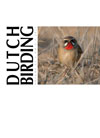Dutch Birding volume 33 (2011) no 2

Spanish Imperial Eagle at Loozerheide in May 2007
On 6 May 2007, a Spanish Imperial Eagle Aquila adalberti was observed by two birders and photographed circling and then flying south-east over migration watch point Loozerheide, Limburg, the Netherlands. The bird was aged as a second calendar-year based on the visible moult of the inner two primaries and the unmoulted juvenile secondaries and tail. Initially, the bird was thought to be a pale Lesser Spotted Eagle A pomarina or 'fulvescens' Greater Spotted Eagle A clanga. The Dutch rarities committee (CDNA) rejected both possibilities and all other eagle species on the Dutch list (including Eastern Imperial Eagle A heliaca) and asked Dick Forsman for help. DF concluded that the bird was a Spanish Imperial Eagle, based on: 1 Greater coverts on underwing. Blackish primary-coverts and greyish greater coverts with diffuse dark centre of Loozerheide bird fit both 'imperial eagles' but not 'fulvescens', which would show contrasting black band. Presence of pale edge on both sides of greater coverts does not fit 'fulvescens' and is good for Spanish Imperial; 2 Markings on underwing and underparts. Median underwing-coverts, armpit and upperbreast look finely streaked in Loozerheide bird, as shown by some Spanish Imperial and excluding Eastern Imperial, which would show more intense streaking, and 'fulvescens', which shows no streaking on these parts. In some photographs of the Loozerheide bird, some blackish streaking is apparently present at side of upperbreast, which is diagnostic for second calendar-year Spanish Imperial with recently moulted body feathers; 3 Throat pattern. Pale throat contrasting with darker upperbreast in Loozerheide bird is typical for 'imperial eagles'; most (but not all) 'fulvescens' have darkish face and throat, darker than upperbreast; 4 Secondaries. Secondaries in Loozerheide bird are barred at base, whereas most (but not all) 'fulvescens' show uniformly dark secondaries; 5 Primaries. Black primaries with greyish base becoming more prominent towards outer primaries fit Spanish Imperial, whereas 'fulvescens' normally has all-black outer primaries (barring in greyish base is present in many Spanish Imperial but not visible in photographs of Loozerheide bird, possibly due to quality of photographs); 6 Primary window. Paler inner primaries of Loozerheide bird form obvious pale window; this feature is typical for 'imperial eagles' but not for 'fulvescens', in which this area is normally darker; 7 Leg length and position. Short tarsus making legs look short and hardly reaching halfway tail (almost level with rear edge of secondaries) in Loozerheide bird fits both 'imperial eagles' and excludes Greater Spotted, which has longer tarsus, reaching halfway tail and toe tips almost reaching tips of undertail-coverts. Leg length is probably the best character to separate Spanish Imperial from Greater Spotted.
The possibility of an (escaped) Tawny Eagle A rapax was also considered but eliminated based on differences in structure (Tawny has longer tail and shorter wings) and Tawny would probably have a more advanced moult stage in early May (but, of course, an individual could show an aberrant moult pattern). Of all Aquila species, Tawny is probably the most difficult to exclude with safety. However, since all characters fit second calendar-year Spanish Imperial Eagle perfectly, the CDNA considered the identification proven beyond reasonable doubt.
The observation was accepted by the CDNA as the first for the Netherlands and the first north of southern France, where five first-years were seen in January, June (two) and September (two) in 1999-2005. In table 1, all known extralimital records are listed. Birds (mainly immatures) regularly cross the Strait of Gibraltar and, apart from Morocco, there are records south to Mauritania (two) and Senegal (one; bird fitted with radio transmitter; distance c 2500 km from Gibraltar). In addition, there is a record of a bird collected in Libya (c 2200 km from nearest breeding areas) and an undocumented report from northern Cameroon. The distance from the nearest breeding areas to Loozerheide is c 1300 km, fitting easily within the known 'dispersal radius' of the species. Spanish Imperial Eagle is a most unexpected addition to the Dutch list; however, the species has shown a strong recovery in breeding numbers in recent decades and wandering of immatures is well documented. There are no reasons to suspect that the bird was an escape (besides, the species is very rare in captivity and all captive birds are closely monitored; in 2002, 33 captive individuals were known, distributed over four breeding programmes). Support for natural vagrancy comes from the fact that it was seen on the final day of an unusually long period of dry and warm weather in the Netherlands that started on 22 March and ended on 6 May.
René Weenink, Sikkel 1, 6026 DH Maarheeze, Nederland (reneweenink planet.nl)
planet.nl)
Nils van Duivendijk, Veluwemeer 82, 3446 JC Woerden, Nederland
(nils.van.duivendijk casema.nl)
casema.nl)
Enno B Ebels, Joseph Haydnlaan 4, 3533 AE Utrecht, Nederland
(ebels wxs.nl)
wxs.nl)
terug






